As I alluded to last week, the Nashville Standard Open would present newfound definition of the Standard format. The last major tournament before the 2011 State Championships and Grand Prix Brisbane, Nashville exceeded expectations and flipped the format right on its ear. Brian Sondag victory with Wolf Run Ramp had far-reaching ramifications, calling for adjustments in removal and sideboard configurations in addition to once again posing an age-old question.
How do you beat a Primeval Titan?
However, Nashville was only the coming-out party for Wolf Run Ramp. The metagame Brian so easily dominated was completely different from the one his victory created. In an effort to better understand the current state of Standard and where it will go from here, let’s examine the Nashville metagame from the top.
Nashville Metagame
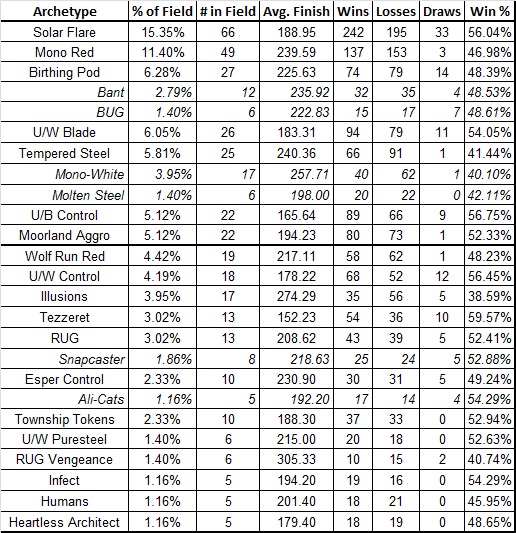
If you compare this chart to the one we saw last week, the first thing you’ll notice is that Solar Flare remained on top with an expected win percentage that reads quite strong. In fact, few decks did this well on the weekend beyond the outlier of Brian Sondag winning run with Wolf Run Ramp—Tezzeret boasted a strong win percentage, but virtually every other archetype hovered in the 40-55% range. That’s a sign that Standard, for the most part, was a pretty fair place during the calm before the storm.
Interesting to see is that U/W Blade dipped while Mono Red jumped. The latter no doubt owes to its twin finals finish from Indianapolis, but the former is more difficult to explain away. Perhaps the rise of Moorland Aggro as a distinct archetype pulled numbers away from U/W Blade? Maybe the poor performance of the archetype during the previous Standard Open merited the sudden abandonment? Either way, not many people were looking to play the deck in Nashville.
Birthing Pod’s holdings diversified this weekend, as the deck remained popular although its Bant versions dipped into significantly lower numbers. On the whole, the archetype continued to underperform, as did Tempered Steel. Adding red, for the most part, did not seem synonymous with adding wins to the deck.
Expected riser U/B Control put up the strongest finish on Tier 1 by a hair. I say expected, because U/B Control has proven it has the tools and means to make it in Standard several times over the past couple seasons—the only question seems to be who you’re fighting. The more defined the metagame becomes, the better U/B performs as players tweak their way to the optimal lists. See Jeremy Neeman Grand Prix victory in Brisbane if you don’t believe me! The real question now is what changes U/B needs to stay abreast of the metagame.
Solar Flare – 15.35% of Field – Won 56.04% of Matches
Best finish: Christian Valenti, 2nd place
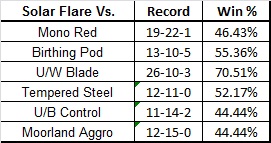
The most popular deck stayed on top in Nashville, with the exact same number of players piloting the archetype as had done so on the previous weekend! A smaller total attendance made Solar Flare a larger slice of the metagame in Nashville, and its popularity indicates that it will see play, even if the metagame experiences some major shifts. The current metagame curves look dismal for the archetype, however. These matchups are nothing worth being proud of—U/W Blade and Birthing Pod are the only decks Flare can boast a convincing win percentage against, and everything else is a flip at best and unfavorable at worst. The fact that Solar Flare pilots had a week to prepare for the Mono Red menace and still couldn’t break even is a bit telling—this shell is not that adaptable.
In the future, I’d expect Solar Flare to eventually fade to Tier 2 as Wolf Run Ramp and U/B Control grow, with players adopting some of its elements into a control frame using two or even the same three colors, but not focusing on Unburial Rites. Sun Titan is the best-performing card in the archetype, combining with Forbidden Alchemy for some serious power—that’s the true core of Flare’s engine, but it’s a combination that can find additional homes.
Mono Red – 11.40% of Field – Won 46.98% of Matches
Best finish: Nick Veccie, 3rd place
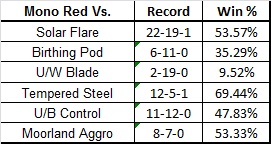
It was no surprise to see players gravitate toward the Indianapolis Standard Open’s best deck…and it was also no surprise to see many of them get punished for it. The top tables featured plenty of red early on, but as the field thinned and the smarter, better, and most prepared players began rising to the top, most Mono Red pilots fell to the wayside—Nick Veccie may have finished third, but he was the only player in the Top 16, a poor showing compared to Solar Flare. Timely Reinforcements, Celestial Purge, and even stranger beats were all spotted doing well in the later rounds. Runner-up in the Standard Open Christian Valenti even had one Purge in his maindeck!
Players came looking to beat Mono Red, and most of them proved capable. Birthing Pod turned unfavorable this weekend, as did U/B Control. Maintaining a winning percentage against Solar Flare is only worth so much when last week’s best matchup, U/W Blade, is now actually smashing the door down and stealing all of your finest china. This week’s sample size for that matchup is smaller, but having played it a few times myself, I’ll attest that it is dismal for the Mountain mage with many of these new lists. Brian Braun-Duin even had maindeck Spellskites—the horror!
This week, most red players will either be adapting or perishing, and my money is on the latter becoming a predominant occurrence. Simply put, it’s tough to win a tournament when people show up expecting to have to beat you. That said, there are certainly many smart ways to build Mono Red, and we could see someone stumble onto a new winning formula.
Birthing Pod – 6.28% of Field – Won 48.39% of Matches
Best finish: Ben Yampolsky, 13th place
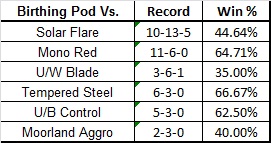
Nashville featured more Birthing Pod variants than Indianapolis had, but the archetype ultimately combined for less of the field than last time. Last week I said stay away from Birthing Pod, and with good reason—it was losing to everything. This week that would appear to have slightly changed, but don’t be deceived by numbers like 6-3, 5-3, or 3-6-1. These aren’t enough matches to draw conclusive percentage results, and you can’t reliably chalk those numbers up to any concrete advantage one way or the other. This still a dangerous time to Pod, and I’d steer clear of conventional lists.
Birthing Pod still has the same awful matchup in Solar Flare, and while I don’t have the data to prove it I’d be willing to bet that most variants are weak to Wolf Run Ramp. That said, Birthing Pod has always given U/B Control a good run for its money due to that color combination’s inability to remove the namesake artifact. If Grand Prix Brisbane does result in a surge of U/B Control decks, I’d keep Birthing Pod in mind as a metagame predator. The deck is complicated and far from a cakewalk to play for every round in a major tournament, but it could have the edge you need over the next month. I say so begrudgingly, of course—it’s still my least favorite deck in Standard!
If you’d like to read about redesigning Birthing Pod for Standard, an article by Patrick Chapin and another by Reid Duke address this very topic.
U/W Blade – 6.05% of Field – Won 41.44% of Matches
Best finish: Brian Braun-Duin, 5th place
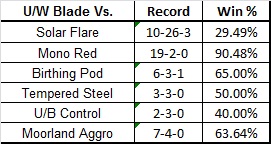
The versatile Blade archetype continued to evolve, and it attacked the Nashville metagame with some limited success. There are still many problems to solve, however. Solar Flare can always stick more Sun Titans than you can Mana Leak, even with Snapcaster Mage’s involvement—you need a better solution. I wouldn’t be surprised to see Dissipate earning some slots in the near future, as it’s a very final answer to the Titan itself as well as Unburial Rites.
Beating U/B Control will be another issue entirely. While the added hard counter could be useful in that matchup as well, I’d be wary—U/B has plenty of maneuverability. Sticking a planeswalker or using better long game threats like Moorland Haunt is probably the best plan of attack for this matchup. Sword of Feast and Famine is still one of your best cards, of course, but it’s clearly not enough as-is. Even something as marginal as Midnight Haunting could go a long way in giving U/W Blade the clock it needs to effectively pressure the slower control deck.
U/W Blade has yet to find a consensus basis build that lends any credence to its claim that it belongs on Tier 1, but I do believe the potential remains. It’s a deck I find myself thinking about tweaking more and more often.
Tempered Steel – 5.81% of Field – Won 41.44% of Matches
Best finish: None in Top 16
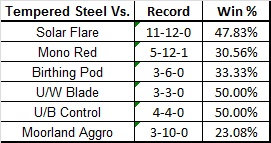
Tempered Steel was a worse Mono Red deck in last week’s matchup analysis. This week, it’s just a bad deck. Ancient Grudge is seeing play in force, and all the cards people are casting to beat tokens and Tezzeret tend to be quite good against Steel. I could go on…but just look at the charts from this week and last week and convince yourself to go elsewhere, please.
U/B Control – 5.12% of Field – Won 56.75% of Matches
Best finish: Caleb Durward, 6th place
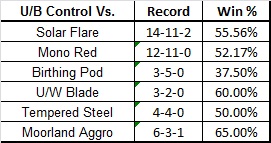
Ah, Brisbane’s big winner. U/B Control was no slouch in Nashville either, and I’d say it’s on the way up. Spot removal combined with sweepers and various forms of card advantage have given U/B Control a winning base from which to cobble a powerful archetype together once again. Expect this archetype to change from week to week, but keep appearing at the top. Worth noting is that U/B Control is far and away the best Snapcaster Mage deck in Standard, if that’s your thing. There are a variety of builds out there worth playing, but all of the best ones appear to favor the 2/1 Tiago significantly.
U/B Control’s weakest matchups on the chart are Birthing Pod, Tempered Steel, and Mono Red—the three decks I’m expecting to see significant decline in coming weeks. If that’s not a reason to reach for the Darkslick Shores, then I don’t know what is!
Moorland Aggro – 5.12% of Field – Won 52.33% of Matches
Best finish: None in Top 16
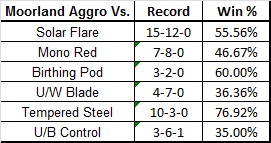
We’ve just begun to understand the Innistrad cycle of allied-aligned lands, and they’ve been impressive. Kessig Wolf Run won the whole tournament, of course, and Gavony Township has received looks for weeks now. Will Moorland Haunt be the next card to explode? It certainly could be. Fighting Inkmoth Nexus and functioning as a recurring threat in control matchups, Moorland Haunt has the potential to be a major player in the Standard format.
I like the idea of pairing the Haunt with Swords or anthem effects like Intangible Virtue in order to increase its effectiveness, but be careful to keep the deck focused and dangerous. You can treat the deck like its own renegade version of U/W Blade, U/W Control, or even build a W/U Tokens strategy using the Township Tokens base—just don’t try to mix too many of these elements together and dilute your ability to play magic.
Decks to Beat in Baltimore
For the Baltimore Standard Open, expect Wolf Run Ramp and U/B Control to be big players, jumping in popularity to together compromise about a fourth of the field, perhaps slightly more. Solar Flare and Mono Red should dip but stay above the 5% mark, as many of their pilots shift to the other two archetypes. I’m not certain what we’ll see happen with the remaining stragglers—Tempered Steel looks like a favorite to drop down into Tier 2, as does Birthing Pod, but regional popularity could affect those numbers.
Having seen it perform at a number of State Championships, I’d expect Tokens to pick up in popularity, both the G/W and U/W varieties. These decks are explosive and likely reasonable threats to U/B Control, making them candidates for promotion this weekend. Another archetype on the rise? Mono-Black Infect! Gerry Thompson has been touting the archetype for a couple weeks now, and it performed well across a small sample size this weekend, including a win at Maryland States. It would appear that Lashwrithe has finally found a home after being one of the most hyped cards from New Phyrexia to do next to nothing in the previous Standard format.
I’ll be in Baltimore myself this weekend, running the coverage of the StarCityGames.com Open Series and continuing to follow the Standard format’s development. Gerard Fabiano and Joey Pasco will be this weekend’s commentators—it should be a blast, so be sure to check out @SCGLive and follow the action on Twitter at #SCGBalt!
Coverage Content Manager
